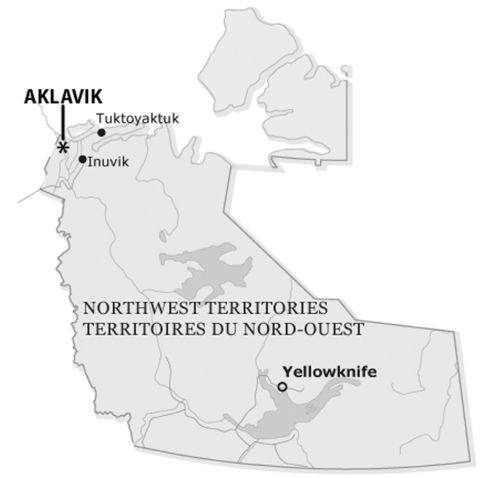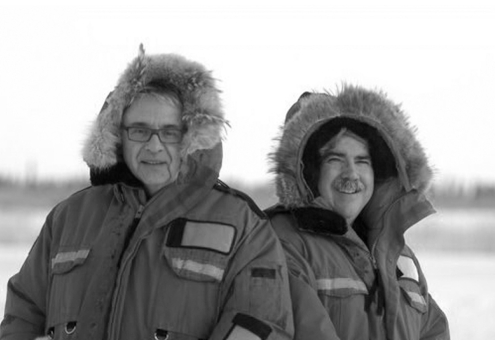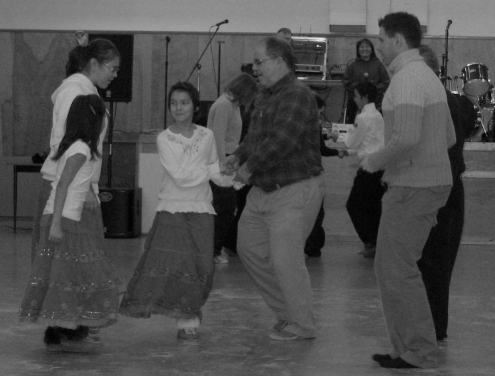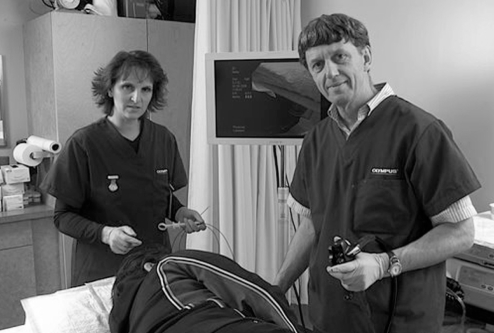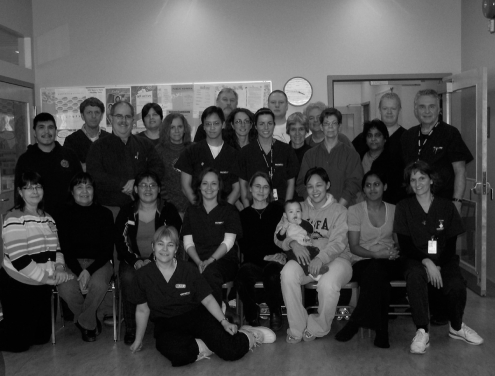Abstract
The Canadian North Helicobacter pylori (CANHelp) working group is a team composed of investigators, health officials and community leaders from Alberta and the Northwest Territories. The group’s initial goals are to investigate the impact of H pylori infection on Canada’s Arctic communities; subsequent goals include identifying treatment strategies that are effective in this region and developing recommendations for health policy aimed at management of H pylori infection. The team’s investigations have begun with the Aklavik H pylori Project in the Aboriginal community of Aklavik, Northwest Territories.
Keywords: Endoscopy, First Nations, Gastric cancer, Gastritis, Helicobacter pylori
Abstract
Le groupe de travail de l’Helicobacter pylori du nord canadien (CANHelp) est une équipe composée de chercheurs, de représentants de la santé et de dirigeants communautaires de l’Alberta et des Territoires du Nord-Ouest. Les objectifs initiaux du groupe consistent à évaluer les répercussions de l’infection à H pylori sur les collectivités de l’Arctique canadien. Les objectifs subséquents incluent le dépistage de stratégies de traitements efficaces dans cette région et la préparation de recommandations de politiques publiques. Les explorations de l’équipe ont commencé par le projet du H pylori à Aklavik, au sein de la communauté autochtone d’Aklavik, dans les Territoires du Nord-Ouest.
The Canadian North Helicobacter pylori (CANHelp) working group is a team composed of investigators, health officials and community leaders from Alberta and the Northwest Territories (NWT). The group’s initial goals are to investigate the impact of H pylori infection on Canada’s Arctic communities; subsequent goals include identifying treatment strategies that are effective in this region and developing recommendations for health policy aimed at management of H pylori infection. The team’s investigations have begun with the Aklavik H pylori Project in the aboriginal community of Aklavik, NWT.
Aklavik is located on the Peel Channel of the Mackenzie River Delta, north of the Arctic Circle (Figure 1). It is accessible year-round by air, in winter by ice road and in summer by boat. Residents are, with few exceptions, of either Gwich’in or Inuvialuit heritage. Aklavik’s motto is ‘Never Say Die’; the phrase originated in the early 1960s, when town members refused to relocate to Inuvik, 50 km downriver east of Aklavik. Inuvik had been designated the new regional centre by the Canadian federal government in response to the frequent flooding to which Aklavik is vulnerable. Aklavik survived the relocation and continues to maintain a population of approximately 600. The town is home to the 1932 burial place of the infamous ‘Mad Trapper of Rat River’ (1).
Figure 1).
Location of Aklavik in the Northwest Territories, Canada. (Map adapted from Canadian Border Services Agency [6])
Aklavik residents and their health care providers have long been concerned about the apparent increase in the incidence of gastric cancer. Aklavik is a small community, but many of its residents have been diagnosed with H pylori infection over the years; the residents are well aware of the association of H pylori with gastric cancer. In fact, in the NWT, gastric cancer ranks as the third most common cause of cancer deaths in men, although it ranks only ninth among men across Canada (2). In the NWT, approximately one-half of the population is Aboriginal – the two main Aboriginal groups are Dene First Nations and Inuit. Gastric cancer is the second most frequently diagnosed cancer among Inuit men and the third among Dene men, although it ranks 10th overall for men across Canada (2). Additionally, the Aklavik community includes recent generations of immigrants from Alaska, where a high prevalence of H pylori infection and high rates of gastric cancer have been documented among Alaskan Aboriginals (3).
Presently, one of the main health concerns of the population is the health risk posed by H pylori infection and how to protect themselves from it. Many Aklavik residents are concerned about H pylori infection increasing their risk of gastric cancer and those whose relatives have succumbed to cancer are particularly concerned. Billy Archie, a former mayor of Aklavik and a current member of the Arctic Health Research Network, has been worried for several years about H pylori infection and was among the first community members to call for research into the disease and solutions to lower its prevalence. When he was mayor, the Aklavik Health Committee decided by consensus that H pylori infection was a community health priority.
Rachel Munday, Nurse-In-Charge of the Aklavik Health Centre, had also noticed the frequent occurrence of H pylori infection and the high level of concern voiced by her patients. This concern spread to Leah Seaman, Medical Health Officer of the Beaufort-Delta Regional Health and Social Services Authority at the Inuvik Regional Hospital, who serves as the family physician for Aklavik residents and to John Morse, director of the Stanton Territorial Health Authority, who provides internal medicine care for Aklavik’s residents. Drs Seaman and Morse had first-hand experience with the difficult-to-treat H pylori infections frequently diagnosed in residents of Aklavik and similar NWT communities. They too, identified H pylori infection as a primary care health problem in the NWT. Chief Medical Health Officer Andre Corriveau also identified a need for research into the distribution and sources of H pylori infection and the associated burden of disease.
Robert Bailey, director of Capital Health’s Northern Health Services Network in Edmonton, Alberta, channelled this call from the NWT for H pylori research to academic researchers at the University of Alberta. Richard Fedorak, then Director of the University of Alberta’s Division of Gastroenterology, who, in responding to the significant community, clinical and research problems posed by H pylori infection in the NWT, began working with University of Alberta researchers to address this community health research need. The Division was the ideal source for such a research team. At the University of Alberta, Professor of Gastroenterology Alan Thomson was already a founding member of the Canadian Helicobacter Study Group. Basic science researchers Diane Taylor and Monika Keelan had long-standing expertise in H pylori microbiology, particularly antibiotic-susceptibility testing and virulence genotyping. Karen Goodman, an epidemiologist with international experience in H pylori infection field studies, had just arrived as a member of the Division of Gastroenterology. She was ready to take the lead on developing a collaborative research program focused on addressing community concerns and improving the clinical management of H pylori infection in Canada’s north. The incoming Director of the Division of Gastroenterology, Sander Veldhuyzen van Zanten, had extensive clinical research experience in H pylori infection. Additionally, Clinical Research Fellow Justin Cheung was ready to focus his efforts on designing and launching the clinical component of the Aklavik project. The team was rounded-out by University of Alberta investigators from other key disciplines: Safwat Girgis, pathologist; Christopher Fletcher, anthropologist; and Carl Phillips, public health policy expert.
As the initial stage of this comprehensive research program on H pylori infection in Canada’s northern aboriginal communities, which ultimately aims to include a full range of northern communities, the collaborative team decided to focus first on investigating the concerns of Aklavik’s residents. Proposals developed for this project incorporated the research principles of the Association of Canadian Universities for Northern Studies (4) and the Alberta Aboriginal Capacity and Developmental Research Environments Network (5). These guidelines were developed to ensure both community participation in the research process and sharing of knowledge with community members. To this end, Karen Goodman made visits to Aklavik to consult with community leaders and establish an Aklavik Study Planning Committee as a mechanism for obtaining community input in project planning. One of the initial actions of the planning committee was giving the project a name: The Aklavik H pylori Project. More importantly, the committee guided the design of a community-based, epidemiological investigation of H pylori infection to:
Screen residents for H pylori infection and collect clinical and epidemiological data;
Provide upper gastrointestinal endoscopies to evaluate the participants’ stomachs and obtain biopsy samples for histopathology assessment and estimation of the prevalence of antibiotic-resistant and virulent bacterial strains;
Conduct a treatment trial to identify effective therapies and follow patients treated long-term to identify factors associated with treatment failure;
Conduct policy analysis to develop cost-effective strategies for the management of H pylori infection; and
Inform community members of the research results in a manner that helps them understand how they can use this information to safeguard their health.
The Aklavik H pylori Project became a full reality when Olympus Canada and Olympus America agreed to provide all of the endoscopy equipment necessary to examine the population of Aklavik and the Capital Health Authority of Alberta’s capital region agreed to provide the nursing and technical staff necessary to perform the procedures and maintain the endoscopy equipment.
Karyn Heavner, a University of Alberta Post-Doctoral Fellow in Epidemiology, was recruited to supervise a field team of three community coordinators who were Aklavik residents and three research assistants who were University of Alberta public health graduate students. The field team conducted community outreach activities to recruit participants and obtain their informed consent, administer clinical surveys, perform urea breath tests, manage data and prepare the community for the arrival of an endoscopy team. Even with a dedicated field team in Aklavik, it was not easy to inform all of the approximately 600 residents (one-sixth of whom are away at any given time) or to motivate all who were contacted to participate. Therefore, three University of Alberta research assistants travelled to Aklavik at the end of December 2007 with the goal of increasing participation. The main strategy was saturation, the three research assistants spent many hours attending community events to inform people about the project. Success was slowly evident as table displays at the local store and post office, school presentations, and delivering radio announcements at key times resulted in more people visiting the health centre to enrol. Nonetheless, the key to enrollment success was to build on the residents’ existing knowledge and growing concern about the health impacts of H pylori infection in their community.
The collection of informed consents and clinical survey data began at the end of November 2007 and urea breath testing commenced in January 2008. In addition to identifying individuals who had gastrointestinal symptoms, previously diagnosed H pylori infections or family histories of gastric cancer, the surveys provided a glimpse into the Aklavik residents’ motivations for wanting this project. The field team also queried participants about their willingness to undergo endoscopy and about whether this choice was dependent on the results of the noninvasive breath test. While a positive breath test was a strong motivator for agreeing to an endoscopic procedure, many asked to be examined regardless of the breath test result, perhaps indicating that a negative diagnosis would give them peace of mind, assuring them of no significant abnormalities with their stomach. Initially, a number of residents were not interested in the project but came forward to participate after hearing from neighbours that their entire families had tested positive for H pylori on the breath tests. Overwhelmingly, when residents were asked if they believed this study was important to Aklavik, the answer was yes. During the initial phase of the Aklavik H. pylori Project, the field team completed clinical surveys for 301 participants of all ages and performed breath tests on 240 participants, 55% of whom tested positive for H pylori infection.
One of the initial goals of the CANHelp group’s endoscopy team was to determine the best way to sample gastric tissue from residents of the Aklavik community. A temporary mobile endoscopy unit was the ideal solution; however, the team had to do some networking to make this idea a possibility given the obvious concerns about performing endoscopic procedures in a remote and isolated town in the Arctic Circle. The need for a safe and adequate facility was resolved by securing access to Aklavik’s recently built and well-equipped Susie Husky Health Centre (Figure 2), which has four offices, six large clinic rooms and a fully equipped emergency room, all managed by Nurse-in-Charge Rachel Munday. Other technical issues related to performing endoscopies in a small community were addressed through the use of the recently developed Olympus 4.9 mm ultrathin transnasal gastroscope. This equipment was piloted by the endoscopy team in Edmonton and allowed for efficient, safe, high-quality endoscopic investigations without the need for sedation; it also offered the benefits of minimal procedural and recovery time. If needed, sedation with propofol was provided by endoscopist John Morse, who routinely administers propofol in his NWT practice. Another major challenge, the need for an adequate number of skilled endoscopy nurses and service aides, was solved through a partnership with Capital Health administrators who agreed to contribute the salaried personnel time of nurses and service aides from the Royal Alexandra and University of Alberta Hospitals. With these elements, a temporary mobile endoscopy unit was created for the Aklavik H pylori Project.
Figure 2).
Susie Husky Health Centre in Aklavik, Northwest Territories
The optimal period to maximize community participation was during the peak of winter, when most Aklavik residents would be in town. Thus, with a team of more than 25 enthusiastic epidemiologists, physicians, nurses, aides and students (all from Edmonton, with the exception of two Yellowknife, NWT physicians), the endoscopy team landed at the Inuvik airport in February 2008. The temperature was −40°C. The team journeyed over the winter ice-road to be hosted in Aklavik for the one-week endoscopy phase of the Aklavik H pylori Project (Figure 3). The week commenced on a Sunday evening with a community meet-and-greet that was well-attended by Aklavik residents. Each evening during the week, residents who had enrolled in the project were called to schedule appointments for the next day. Endoscopy team members appeared on local radio during the evenings to encourage residents to visit the Health Centre to be tested, even if they had not previously signed up. Team members also encouraged residents during various social events throughout the week to attend the clinic at the Health Centre (Figure 4). These events included lunches at the preschool and the Gwich’in Band office, a youth dance presentation at the community arena, health careers presentations to high school students, tours of the school, curling, visits to the market and crafts shop and evening patrols.
Figure 3).
February 2008 arrival in Aklavik, Northwest Territories. Robert Bailey (Left) and John Morse (Right). (Photo by Karen Karbashewski)
Figure 4).
Dancing with local children at the Aklavik Welcome Event for the endoscopy team
In all, the mobile endoscopy unit examined almost 200 individuals, taking gastric biopsies at the same time (Figure 5). The processing and analysis of specimens is in progress at the University of Alberta. Subsequent phases of the Aklavik H pylori Project have been initiated, and future protocols are being planned. These protocols include treating all infected participants with individualized treatments based on the results of antibiotic-resistance testing. The benefits to come will result from a strong collaboration across institutions and provinces, and among academic researchers, health care providers and community leaders, all motivated by the goal of addressing community health risk concerns about H pylori infection (Figure 6).
Figure 5).
Unsedated transnasal endoscopy in Aklavik, Northwest Territories. Sander Van Zanten (right) and Kathy Korner (left). (Photo by Karen Karbashewski)
Figure 6).
Endoscopy team with local research assistants at the Susie Husky Health Center in Aklavik. (Photo by Karen Karbashewski)
CANHelp WORKING GROUP
Aklavik, NWT:
Rachel Munday (Aklavik Health Centre); Robert Buckle, Glen Gordon, Annie Buckle, Jerome Gordon, Andrew Gordon (Aklavik Health Committee); Billy Archie (Arctic Health Research Network). Inuvik, NWT: Leah Seaman (Inuvik Regional Hospital), Crystal Lennie (Inuvialuit Regional Corporation). Yellowknife, NWT: Andre Corriveau (NWT Health and Social Services), John Morse (Stanton Territorial Health Authority), Susan Chatwood (Arctic Health Research Network).
Edmonton, AB:
Karen Goodman, Justin Cheung, Michael Arget, Richard Fedorak, Christopher Fletcher, Safwat Girgis, Karyn Heavner, Janis Huntington, Monika Keelan, Carl Phillips, Robert Rennie, Larissa Shamseer, Joanne Simala-Grant, Sander Veldhuyzen van Zanten (University of Alberta); Robert Bailey (Capital Health Northern Health Services Network).
Acknowledgments
We wish to acknowledge the contributions of Stanton Territorial Hospital (Yellowknife, NWT) gastroenterologist Tom Guzowski; Misericordia Hospital (Edmonton, AB) gastroenterologist Mario Millan; Capital Health (Edmonton, AB) patient care managers Susan Derk and Brenda Holowaty; University of Alberta Hospital and Royal Alexandra Hospital (Edmonton, AB) endoscopy nurses Leanne Ellis, Jennifer Antonio, Sheila Berrisford, Kathy Korner, Cinnamon Landhauser, Paula Ledsham, Louise Steffan, and service aides Austin Babb, Tamara Bangs, Tammy Church and Sharda Naidu; Olympus Canada personnel Peter Bresee and Dale Kennedy; and Inuvik Regional Hospital endoscopy aide Louie Goose.
Footnotes
FUNDING: Justin Cheung (MD, FRCPC) is a clinical research-fellow supported by fellowships from CAG/CIHR/Ferring and the Alberta Heritage Foundation for Medical Research. The activities of the Aklavik H pylori Project to date have been supported by funds from the Social Sciences and Humanities Research Council of Canada, the University of Alberta Division of Gastroenterology, the Northwest Territories Health and Social Services, and the Inuvialuit Regional Corporation, along with in-kind contributions from Olympus Canada, Canadian North Airlines, Capital Health, Inuvik Regional Hospital, Susie Husky Health Centre, Aklavik Community Corporation, and Aklavik residents and community groups who housed and fed endoscopy team members.
REFERENCES
- 1.Northwest Territories Beureau of Statistics Aklavik. < http://www.stats.gov.nt.ca/Infrastructure/Comm%20Sheets/Aklavik.html> (Version current at June 25, 2008).
- 2.Department of Health and Social Services, Government of the Northwest Territories Cancer in the Northwest Territories, 1990–2000. A descriptive report. 2003 < www.hlthss.gov.nt.ca> (Version current at June 25, 2008).
- 3.Goodman KJ, Jacobson K, Veldhuyzen van Zanten SJ. Helicobacter pylori infection in Canadian and related Arctic Aboriginal populations. Can J Gastroenterol. 2008;22:289–95. doi: 10.1155/2008/258610. [DOI] [PMC free article] [PubMed] [Google Scholar]
- 4.Association of Canadian Universities for Northern Studies . Ottawa: 2003. Ethical Principles for the Conduct of Research in the North. www.acuns.ca/EthicsEnglishmarch2003.pdf> (Version current at June 25, 2008). [Google Scholar]
- 5.Alberta ACADRE Principles for Aboriginal Health Research. Aboriginal Health Research Networks Secretariat. <www.acadre.ualberta.ca/index.cfm> (Version current at June 25, 2008).
- 6.Canadian Border Services Agency Directory of Offices. Maps. Northwest Territories. < www.cbsa-asfc.gc.ca/do-rb/map-carte/nt-eng.html> (Version current at June 25, 2008).



